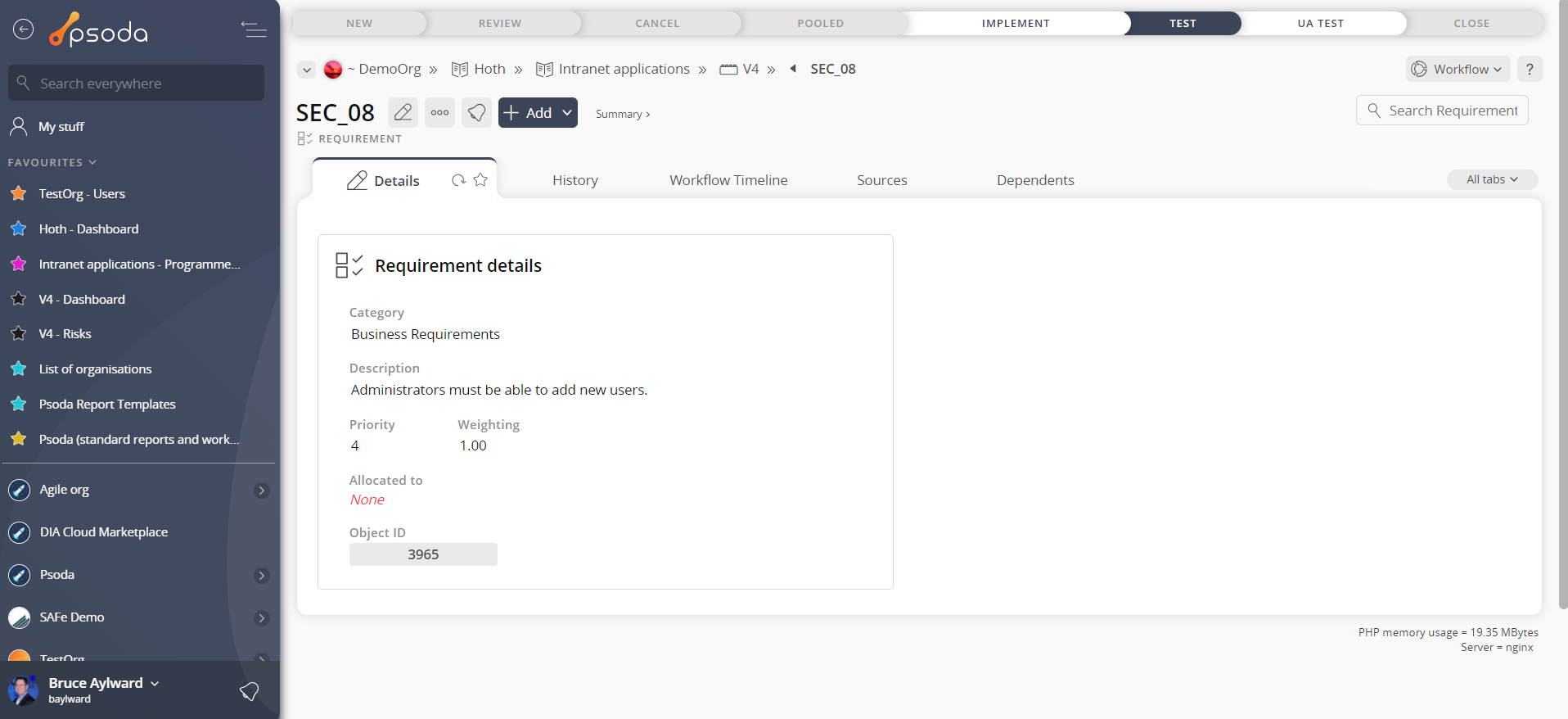
Figure 1 – Requirement view page
The top header area allows you to Attachments
Attachments
This tab shows an asset listing of all of the attachments that have been added to this requirement, as shown in Figure 2. By default, this table will present you with a number of details about the attachments such as the file’s name, attachment type, view the version and access a download link.
From the Actions column of this attachments table, you can act on individual attachments by 
Figure 2 – Requirement attachments tab
Note that you can customise your table view by clicking the Comments
Comments
This tab shows an asset listing of all of the comments that 
Figure 3 – Requirement comments tab
Note that you can customise your table view by clicking the Dependents
Dependents
Dependents are other assets, for example test cases, that “depends” on this requirement i.e. those assets may be affected if the details of this requirement should change.
This tab shows an asset listing of all of the dependents that have been added to this requirement, as shown in Figure 4. By default, this table will present you with the dependent’s parent asset, the dependent asset, it’s description and status.
From the Actions column of this dependents table, you can act on individual dependents by 
Figure 4 – Requirement dependents tab
Note that you can customise your table view by clicking the edit button at the bottom of the dependents table or navigate to this same spot to
add more dependents to this requirement. Here, you can also export this list to
Excel or
CSV files.
 Details
Details

Figure 5 – Requirement details tab
This tab shows some additional details about the requirement, such as it’s category, description, weighting, priority and which users this requirement is allocated to, as shown in Figure 5. History
History
This tab shows shows some basic history of the requirement, as shown in Figure 6. By default, this tab will present you with a number of details about the requirement’s history such as the creation date, creation user, last update date and last update user. If the requirement has been changed then this section will also show a table of all the changes that has been made, including the date of each change, the field changed, the value before the change and the user who made the change.
Figure 6 – Requirement history tab
Note that you can customise your change table view by clicking the edit button at the bottom of the change table. Here, you can also export this list of changes to
Excel or
CSV files.
 Sources
Sources
Sources are other assets that this requirement is derived from, i.e. this requirement can be affected if any of its sources are changed.
This tab shows an asset listing of all of the sources that have been added to this requirement, as shown in Figure 7. By default, this table will present you with the source’s parent asset, the source asset, it’s description and status.
From the Actions column of this sources table, you can act on individual sources by 
Figure 7 – Requirement sources tab
Note that you can customise your table view by clicking the edit button at the bottom of the sources table or navigate to this same spot to
add more sources to this requirement. Here, you can also export this list to
Excel or
CSV files.
 Sub-requirements
Sub-requirements
This tab shows an asset listing of all of the sub-requirements on this requirement, as shown in Figure 8. By default this requirements table will list some details for the sub-requirements such as the relationship, reference, category, description, priority, weighting and current state. If you click on the link in the reference column, you will navigate into the selected sub-requirement’s view page.
From the Actions column of this sub-requirements table, you can act on individual requirements by 
Figure 8 – Requirement sub-requirements tab
Note that you can customise your table view by clicking the Test cases
Test cases
This tab shows an asset listing of all of the test cases that have been listed for this requirement, as shown in Figure 9. If you click on the link in the reference column, you will navigate into the selected test case’s view page. By default this test cases table will show some details of the listed test cases such as the reference, title, pre-conditions, description, requirement being tested, current state and the last result.
From the Actions column of this test cases table, you can act on individual test cases by 
Figure 9 – Requirement test cases tab
At the bottom of the table you can add more sub-folders or
test cases manually or
import multiple from a CSV file. Note that you can customise your table view by clicking the
edit button from here too, as well as being able to export this list to
Excel or
CSV files.
 Workflow timeline
Workflow timeline
This tab shows you a table containing each of the state transitions that have been applied to this requirement on the associated workflow. Note that you can customise your table view by clicking the  Figure 10 – Requirement workflow timeline tab
Figure 10 – Requirement workflow timeline tab
Below the state transition timeline table, you will be presented with a visual breakdown of the timeline in a GANTT chart, as shown in Figure 10.